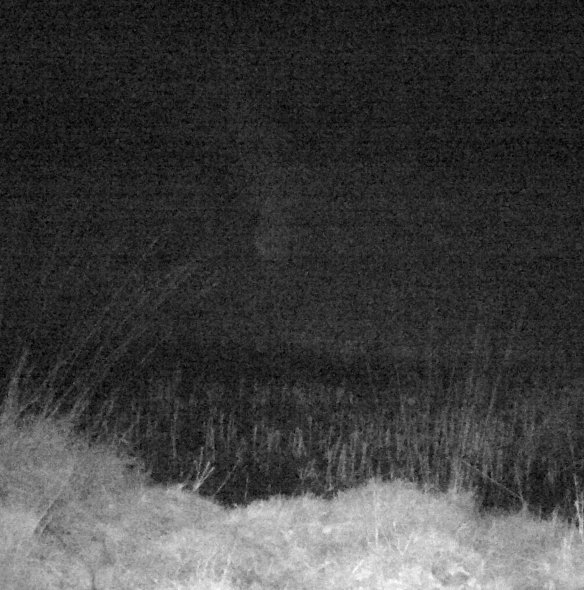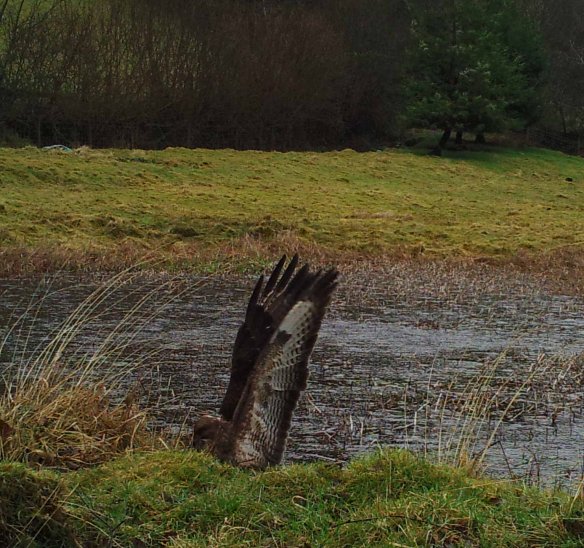When we had a small pond dug out in our upper wet meadow some 17 years ago, we thought it would be a great environment for amphibians and invertebrates like damsel and dragon flies. We didn’t expect that unusual plant species like Lesser Bladderwort, which Richard Pryce, the county’s botanical recorder, found in it last August, would move in so quickly.
Then about 3 years ago we began to wonder what was predating the frogs and toads – we kept finding half eaten carcases on the banks after spawning time.  Eventually we worked out these were half eaten toads, and that possibly otters were responsible since some otter populations have worked out how to do this, and leave the toxic parts of the toad behind.
Eventually we worked out these were half eaten toads, and that possibly otters were responsible since some otter populations have worked out how to do this, and leave the toxic parts of the toad behind.
Last year we’d borrowed a trail camera and caught a few images of an otter (above). This year we had our own so have had it set up for much of the time since the first frogspawn appeared in this pond on February 2nd.
What we didn’t expect to see was what the poor frogs have to contend with. It seems many birds and animals want a piece of the action. The toads have still not arrived, but I’ve now worked out that from a distance the frogs can be clearly heard, and frequent ripples seen on the surface where they break through. But move too quickly or loudly, and they all dive and try to hide themselves in the muddy base of the pond.
First up is the buzzard which always selects a higher vantage point, away from the pond’s edge before making a snatch and grab attempt for an unsuspecting frog…  But it’s not a foregone conclusion it will succeed, and it seems from the pictures below that frog reaction times are sufficiently fast to allow if to leap out of reach of those talons.
But it’s not a foregone conclusion it will succeed, and it seems from the pictures below that frog reaction times are sufficiently fast to allow if to leap out of reach of those talons.

 Look closely at the image above. The grey splurge to the right of the buzzard’s head, with bulging eyes is a frog leaping for its life to escape. And a wet, empty taloned, buzzard on the bank afterwards, below…
Look closely at the image above. The grey splurge to the right of the buzzard’s head, with bulging eyes is a frog leaping for its life to escape. And a wet, empty taloned, buzzard on the bank afterwards, below… 
At night it seems that there’s a host of animals that regularly visit the pond – fox, otter and polecat.

 (It’s also interesting that the otter and fox photos immediately above, were taken within about 10 seconds of each other. Presumably the fox was looking into the pond at the otter, which then emerged onto the bank.)
(It’s also interesting that the otter and fox photos immediately above, were taken within about 10 seconds of each other. Presumably the fox was looking into the pond at the otter, which then emerged onto the bank.)
By day as well as the Buzzard there have been Herons, Crows and Jays.
I even found some pellets on the bank which I first took to be fur balls, but someone else has told me are probably regurgitated fur pellets from the buzzard. And also what may be a buzzard’s explosive linear defaecation? A black sludge followed by a long ( 30 cm plus) white line. Ideas anyone?
And also what may be a buzzard’s explosive linear defaecation? A black sludge followed by a long ( 30 cm plus) white line. Ideas anyone?
What has interested me is that all the frogs seem to spawn in just 2 quite small sections of the bank – probably less than 5 % of the total. And I’ve a suspicion that these are the same bits of bank chosen each year. The question is why? Whilst one area could perhaps be a little warmer, since it’s more South facing, the other one is quite shaded and North facing.
Has anyone else with a meadow pond noticed whether their spawn is always produced in quite a small bit of the pond. And does anyone know why this might be?
On one of the images from the camera, ( above), I studied it for ages to work out what had triggered the Infra Red movement sensor. And then I thought I could see a vague owl silhouette just above the pond’s surface in the centre of the image. Mentioning this to a friend, Colin, who is a fellow Cothi Gardener and on the steering group of Carmarthenshire Meadows, he very kindly sent me a couple of video clips from February 2017, which he’s recorded from his own pond, where a tawny owl flies in to perch on the top rung of the stepladder on which his homemade camera /monitor is set up.
It then takes off from this vantage point and plucks frogs off the pond’s surface, much as an osprey would catch a fish. The bright dots above are frog’s eyes above water level.
Amazing stuff, Colin. Thanks for sharing these fantastic video clips with the Meadows Group.
We’re even more glad now that we decided to have the simple pond dug out all those years ago since it’s obviously a hive of activity, even at night. And even in February.
Thanks for reading..







Another wonderful post Julian with such interesting facts and amazing photos and video! I know what I want for Christmas now…a trail camera( is that what an infra red camera is called?) Our frog spawn is also in the same place every year…I’d never thought about that before…how curious! I’ve seen those fur balls here too…amazing what you learn on a wet, windy and disappointing ( rugby!) Saturday afternoon.
LikeLike
Thanks Marianne. Nice to have some proper wet weather to get his done – and a distraction from the rugby as you say. There are vast numbers of trail cameras, and mine packed up after 2 months! But fortunately Bushnell got it replaced just in time for the frogs. We (i.e. the Meadows Group events sub group) are thinking about holding an event sometime which would feature options for photography “in the field”. Unfortunately it probably won’t be this year, since we have a full timetable now, but I’m really interested in what Colin is achieving – he can even look at his cameras output in real time streamed onto his mobile phone ….he’s a very clever chap!
Interesting your frogs are selective in spawning locations – maybe you could work out aspects/features of the bits of pond bank that they use, and share them with us sometime?
best wishes
Julian
LikeLiked by 1 person
It is interesting that the frogs did not detect the owl when it glided right over the top of them in the first video. They would have disappeared instantly had they done so. It shows how quiet an owl is in flight, and presumably it was a dark night so they did not see it against the sky.
LikeLike
That’s a really interesting point, Colin. Thank You. I wonder what frog vision is like in the dark anyway? Something to look up sometime, I think, and thanks again for these amazing shots,
best wishes
Julian
LikeLike
When you dug your pond did you need to use any form of lining? Does it stay full year round? How deep did you make it? Did you introduce any plants yourself or just let nature take over? Enough questions! Thanks Jo
LikeLike
Hello Jo,
Thanks for the comment.
Briefly in reply…
No liner, just dug out with a JCB, after the JCB driver tweaked some rods around re water divining and said this was the spot!, But frankly so wet here unlikely to ever dry out, and it never has. It has one of the drainage ditches running in at the top, and out at the lower end. Also clay/peat subsoil. Depth maybe 18 inches to 2 feet in middle, but gradually silting up. Pretty much left nature to colonise it, though did add some cotton grass seeds round the edge. But clearly lots of native stuff like Bog Bean in the wet meadows which have moved in.
Best wishes
julian
LikeLike
Thanks for the info. I just need to find a divining JCB driver now!
LikeLiked by 1 person
Fascinating and the video clip is outstanding. The Botanic Garden’s conservation volunteers captured a night time image of a polecat with a big frog in its mouth 2/3 years ago – our first confirmed record of a polecat here. They also obtained film of an otter on one of our lakes last month – again, the first recorded sighting of otters here. Night time cameras really are good.
LikeLike
Thanks for the comment Bruce and interesting that the NBGW have similar records – its been a complete revelation to me that so much is happening after dark around such a small pond,
best wishes
Julian
LikeLike
I’ve noticed the frogs lay their spawn altogether in certain spots, near the bank and the same places each year in my ponds too. I have thought that these were chosen for being shallow so the spawn does not sink down to the bottom and out of the warmth where the suns rays can reach. I have carried spawn from a deep puddle that dries up nearby to the newest pond so that frogs developing there will come back in a few years time- I noticed that it sinks, rather muddy, below the surface in deeper water as I tip it out of the bucket. I guess some females are caught short waylaid by males. I am sure there is activity- fox otter herons… I find a few masses of spawn removed and dropped on a field nearby, I don’t know which creature is responsible for that. If a female frog is killed the spawn released is tight and small, unfertilised and never laid in water. The frog spawn in the ponds looks like a barrow load tipped in filling a shallow bit of the water near the edge resting on the bottom and breaking the surface. I don’t have any toad spawn yet. I also have much longer vegetation round most of my ponds- I’ve never seen a buzzard there but I have seen kites passing low over the pond field looking for frogs hopping unwarily in the daylight to snatch them up like an osprey as they do rodents in the cut hay meadows.
LikeLike
Hello Ruth,
Thanks for adding to this very interesting discussion. This blog post is going to be reblogged apparently on the Freshwater Habitats Trust blog, so maybe we shall get some additional comments about this subject in due course,
best wishes
Julian
LikeLike